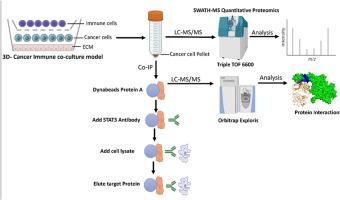STAT3相互作用组预测了口腔鳞状细胞癌中调节免疫系统的蛋白质的存在。
IF 2.3
Q1 DENTISTRY, ORAL SURGERY & MEDICINE
引用次数: 0
摘要
目的:信号转导和转录激活因子 3(STAT3)是与增殖机制相关的关键蛋白之一,有助于口腔鳞状细胞癌(OSCC)的进展。STAT3 的免疫逃避是由 JAK2/STAT3/PDL1 信号轴介导的。基于之前的研究结果,我们假设 STAT3 结合伙伴参与了 OSCC 抗肿瘤活性的抑制:方法:我们利用口腔癌细胞系 SCC4、SCC9、SCC25 和 CAL27 以及正常口腔细胞系 OKF6 构建了三维癌症-免疫共培养模型。细胞与自然杀伤细胞(NK-92)和Jurkat细胞共培养。根据 SWATH 数据选择了目标蛋白 STAT3,并进行了基于共免疫沉淀(Co-IP)的蛋白质组学研究。对共沉淀 LC-MS/MS 产物进行分析,以确定蛋白质相互作用网络、基因本体、通路分析和蛋白质集群注释:结果:口腔癌细胞系中的 STAT3 与表皮生长因子受体(EGFR)及其他参与增殖和免疫机制的蛋白质相互作用。蛋白质组分析表明,本研究发现的一些 STAT3 结合蛋白是已知的免疫系统调节因子:总之,STAT3 交互蛋白可调节口腔鳞状细胞癌细胞的免疫系统。本文章由计算机程序翻译,如有差异,请以英文原文为准。

STAT3 interactome predicts presence of proteins that regulate immune system in oral squamous cell carcinoma
Objectives
Signal transducer and activator of transcription 3 (STAT3) is one of the key proliferation mechanism–related proteins that helps in oral squamous cell carcinoma (OSCC) progression. Immune evasion by STAT3 is mediated by the JAK2/STAT3/PDL1 signaling axis. Based on previous findings, we hypothesized that STAT3-binding partners participate in the inhibition of anti-tumor activity in OSCC.
Methods
A 3D cancer-immune co-culture model was constructed using oral cancer cell lines SCC4, SCC9, SCC25, and CAL27 and normal oral cell line OKF6. The cells were co-cultured with natural killer (NK-92) and Jurkat cells. The target protein STAT3 was chosen based on SWATH data, and co-immunoprecipitation (Co-IP)-based proteomics was conducted. The Co-IP LC-MS/MS output was analysed to determine the protein interaction network, gene ontology, pathway analysis, and protein cluster annotation.
Results
STAT3 in oral cancer cell lines interacts with the epidermal growth factor receptor (EGFR) and other proteins that participate in proliferation and immune mechanisms. Proteome analysis showed that some STAT3-binding proteins found in this study are known immune system regulators.
Conclusion
Overall, STAT3 interactive proteins regulate the immune system in oral squamous cell carcinoma cells.
求助全文
通过发布文献求助,成功后即可免费获取论文全文。
去求助
来源期刊

Journal of Oral Biosciences
DENTISTRY, ORAL SURGERY & MEDICINE-
CiteScore
4.40
自引率
12.50%
发文量
57
审稿时长
37 days
 求助内容:
求助内容: 应助结果提醒方式:
应助结果提醒方式:


